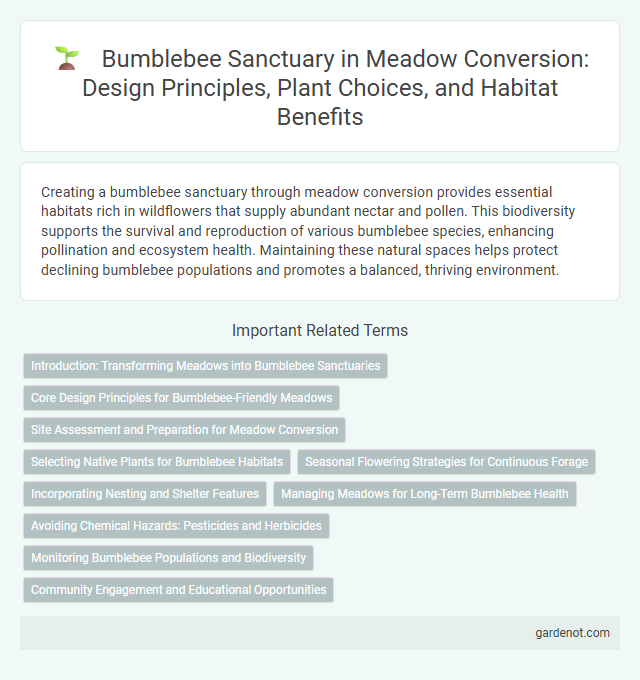Creating a bumblebee sanctuary through meadow conversion provides essential habitats rich in wildflowers that supply abundant nectar and pollen. This biodiversity supports the survival and reproduction of various bumblebee species, enhancing pollination and ecosystem health. Maintaining these natural spaces helps protect declining bumblebee populations and promotes a balanced, thriving environment.
Introduction: Transforming Meadows into Bumblebee Sanctuaries
Meadow conversion into bumblebee sanctuaries enhances pollinator habitats by restoring native wildflowers and creating diverse nectar sources. This transformation supports bumblebee populations, improves biodiversity, and contributes to sustainable ecosystems. Strategic planting and habitat management are key to maximizing floral resources and nesting sites for bumblebee species.
Core Design Principles for Bumblebee-Friendly Meadows
Bumblebee-friendly meadows prioritize native flowering plants that provide continuous nectar sources throughout the growing season, supporting diverse bumblebee species and their foraging needs. Structural diversity, including varied plant heights and dense patches, creates optimal nesting habitats and protection from predators. Maintaining pesticide-free zones and incorporating early-flowering species ensures a sustainable environment crucial for bumblebee population health and biodiversity conservation.
Site Assessment and Preparation for Meadow Conversion
Site assessment for meadow conversion at a bumblebee sanctuary involves detailed analysis of soil composition, native flora presence, and existing pollinator activity to ensure optimal habitat conditions. Preparation includes removing invasive species, enhancing soil nutrients organically, and designing plant palettes rich in nectar and pollen sources tailored to local bumblebee species. Monitoring microclimate factors such as sunlight exposure and moisture levels supports long-term sustainability and maximizes pollinator support.
Selecting Native Plants for Bumblebee Habitats
Selecting native plants such as wild bergamot, goldenrod, and purple coneflower enhances bumblebee habitats by providing essential nectar sources and nesting materials. Native flora supports local bumblebee species by offering bloom periods that align with their life cycles, ensuring continuous food supply throughout the seasons. Incorporating diverse native plant species in meadow conversion projects promotes ecosystem resilience and boosts bumblebee population sustainability.
Seasonal Flowering Strategies for Continuous Forage
Bumblebee sanctuaries benefit from seasonal flowering strategies that ensure continuous forage by incorporating a diverse mix of native wildflowers and grasses blooming at staggered intervals throughout spring, summer, and autumn. Selecting plant species with overlapping flowering periods maximizes nectar and pollen availability, supporting bumblebee colony development and enhancing pollination efficiency. Integrating early bloomers like crocus and late-season flowers such as sedum sustains bumblebee populations during resource-scarce months.
Incorporating Nesting and Shelter Features
Incorporating nesting and shelter features within a bumblebee sanctuary enhances habitat suitability and supports population growth. Utilizing natural elements such as tussocky grasses, hollow stems, and soil mounds provides essential nesting sites and overwintering protection. These features create microhabitats that promote foraging efficiency and reproductive success in native bumblebee species.
Managing Meadows for Long-Term Bumblebee Health
Managing meadows through seasonal mowing and controlled grazing promotes diverse flowering plants essential for bumblebee foraging and nesting. Maintaining a mosaic of native wildflowers and undisturbed patches ensures continuous nectar sources and habitat connectivity, crucial for sustaining bumblebee populations. Integrating pesticide-free practices and monitoring plant bloom cycles enhances long-term bumblebee health and supports broader pollinator biodiversity.
Avoiding Chemical Hazards: Pesticides and Herbicides
Bumblebee sanctuaries thrive when chemical hazards like pesticides and herbicides are strictly avoided, as these substances disrupt bumblebee foraging behavior and reproductive success. Implementing organic meadow conversion practices enhances floral diversity, providing safe nectar and pollen sources critical for bumblebee colony health. Prioritizing pesticide-free environments directly supports pollinator population recovery and ecosystem resilience.
Monitoring Bumblebee Populations and Biodiversity
Monitoring bumblebee populations within meadow conversion areas is critical for assessing ecosystem health and biodiversity. Regular population surveys and habitat quality assessments provide valuable data on species diversity and abundance, informing conservation strategies. Advanced techniques such as acoustic monitoring and DNA barcoding enhance accuracy in tracking bumblebee species and their ecological roles.
Community Engagement and Educational Opportunities
Bumblebee sanctuaries within meadow conversions serve as vital community hubs, promoting biodiversity and environmental stewardship through interactive workshops and citizen science projects. Educational opportunities include hands-on experiences that teach pollinator ecology, fostering local awareness and involvement in conservation efforts. These initiatives strengthen communal ties and inspire sustainable practices that support bumblebee populations and meadow ecosystems.
Bumblebee sanctuary Infographic

 gardenot.com
gardenot.com